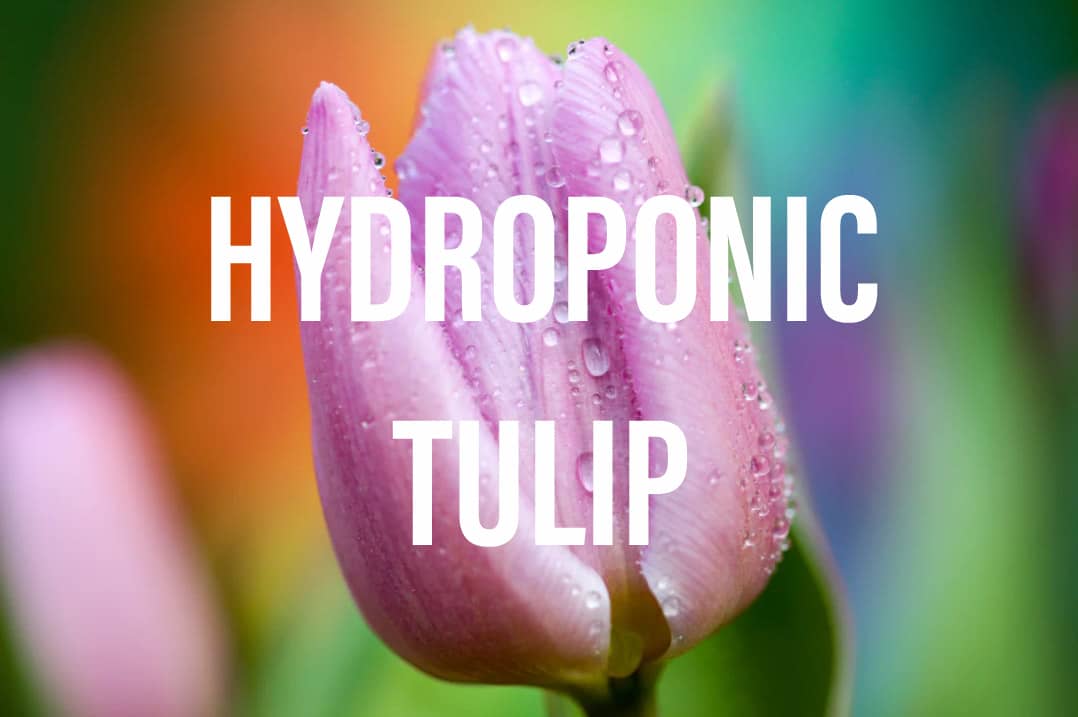Tulips are one of the most beautiful types of flowers. These are grown and admired worldwide. People use these flowers on large scale for gardening, decoration, gifts, and wedding adornments. Where ever used, these flowers add to the beauty and serenity of the environment. There are different colors and kinds of tulips. There are many other beautiful flowers but the tulips were pretty enough to mesmerize and inspire the poets and estheticians through the ages. It is cultivated both on commercial and domestic levels. In past, the traditional soil cultivation was the only method to be used. With the era of modernization, the harvesting techniques were also innovative and rectified. Hydroponic Tulips are the products of one such modernized farming method.
The hydroponic cultivation method is getting pretty famous since the ending of the 19th century. The tulips grown in water with the bulbs still intact are called Hydroponic Tulips. This is basically a technique of growing tulips without in water, which can be in vases or bottles as well. Hydroponic tulips are not like ordinary cut tulips that have a much lesser life.
You can enjoy the full beautiful natural flower growth cycle in a vase, inside your house, or in your bedroom. If received before budding, the color of the bouquet will be a surprise and you have to wait a few days to see the colors of the flowers. And the good thing is that these bulbs can be transferred to soil, once the blooming process is complete. Isn’t it great?
In this article, we will share information about hydroponic tulips, growth techniques, aftercare, re-growth methodology, and the pioneer seller.
The technique of Hydroponic Cultivation

The specific technique used to grow plants by water is known as hydroponics. Tulip bulbs of good quality are used which are free from harmful bacteria or molds. In Holland, the trend of growing tulips hydroponically was introduced in the late 1990s. This trend has grown enormously in the later years. The method followed on the commercial level of cultivation is summarized below:
- The suitable bulbs are obtained and placed in the specific water trays.
- In the next step, the trays are kept in cold rooms with a temperature of around 8 degrees centigrade. This is done to enable the dormancy to be finished.
It is important to mention that the design and material of the trays are also important in the cultivation. The bulbs should be placed upright without being damaged by the needles. There are a few popular tray manufacturers in Holland supplying suitable trays for hydroponic forcing of tulips. - Then the water is added to the trays returning them to cold storage at a temperature of 3 to 5 degrees. The bulbs are kept here for about three weeks. This time period can be reduced up to 10 days in the last months of the year. 4 cm of the root is grown in this stage which is enough to absorb the water. Calcium nitrate is added to aid the healthy growth of the plant.
- After the roots have grown, the bulbs are sent to greenhouses. These greenhouses are kept at a warmer temperature which is modified between 21 to 16 degrees on different stages. The plants are watered by pipes lying over the boxes.
- Cleanliness is not ignored here and boxes are regularly sterilized at a higher temperature of around 60 degrees Celsius to avoid any kind of harmful bacteria, molds, or other microorganisms.
Pros of Hydroponic Growth

As compared to the traditional soil and peat method, the undermentioned advantages are observed due to hydroponic forcing:
This technique reduces the time span, energy, and expense of harvesting.
- Bulbs can be chilled at lower temperatures.
- It is a relatively clean process with no soil handling.
- The bulbs produced are pretty easier to clean as compared to the soil ones because they are water grown and soil does not come in contact to contaminate the flowers.
- Hydroponic tulip bulbs after they bloom can be transferred into the soil as well. So if you receive a bouquet as a birthday gift, you can make it enhance the beauty of your garden without wasting the bulbs.
Cons of Hydroponic Growth of Tulips
As with everything and every technique, hydroponic growth technique also comes with some particular disadvantages as well;
- Not every bulb is suitable for hydroponic forcing. High quality and disease-free bulbs are suitable for the process.
- The flowers grown by this technique are somewhat lower in size and quality as compared to the ones grown in soil. The soil tulips are around 2 inches bigger and 8% stronger than the water grown tulips. Although fresher researches are introducing plantation and temperature adjustments to solve this issue.
- The storage and fixing of the hydroponic tulip bulbs in the trays are somewhat tricky. This needs properly trained cultivators to do the task. Risks of contamination are higher so proper machine cleaning is required on large scale production.
Growing Hydroponic Tulip Bulbs at Home

Growing Tulips Hydroponically at home is a pretty easy and interesting activity for people having a taste for gardening. A few simplified steps are stated below as your guide to cultivating hydroponic tulip bulbs at home.
- Initially, the bulbs are chilled using a paper bag in your fridge for about 13 weeks. You can also use pre-cooled bulbs easily available in the markets in the season.
- Now take some beads or pebbles and fill them 2 inches in a vase of your choice. You can select the vase according to the interior of your room.
- Now put the bulb inside the vase on the pebbles. Add water up to one inch of the lower portion of the bulb to provide moisture to the roots without wetting the bulb. Let the hydroponic tulip vase rest in a dark and cool place for about 5 to 6 weeks until the sprouting makes you excited. The water should be changed every week to avoid any kind of contamination.
- After about 15 weeks, the sprouted bulb can see the sun through a window of your house. The golden sunlight will energize the bulbs and they will soon turn into the stem and green fresh leaves.
- Isn’t it interesting? If you decide to enjoy the natural process of this beautiful flower, do not forget to change the water weekly and keep the level constant. Your pretty hydroponic tulips will beautify your corner for a couple of weeks.
Hydroponic Tulips Care

The beautiful water has grown tulips after bloom needs a little care to maximize life. Basic points to be followed are as under;
- Vase or container should be kept in a fresh room with plenty of sunlight. However direct sun exposure is to be strictly avoided as it destroys the delicate buds.
- It should be rotated weekly to ensure uniform sunlight exposure to all the bulbs and all sides of leaves.
- The temperature has to be kept lower but above the freezing point. The optimum temperature is considered to be 60 t0 65 degrees Fahrenheit, for the maximum life of these flowers.
- Roots should be kept in water and avoid dipping the bulbs in. Bulbs should be not more than 2/3 of its total height in the water.
- Water changing should be done while keeping the roots safe from damage.
Will Hydroponic Tulips Rebloom

People often want to know about the reblooming of the hydroponic tulip bulbs. Here we will solve your query. Once the first bloom has faded away, just cut the withered flower heads and keep the vase in the sunlight with all the bulbs and the stem inside. It may bloom again into another cycle, letting you enjoy the beauty once again.
Hydroponic tulip bulbs after they bloom twice rarely bloom again. After cutting the flower heads for the second time, you can let the foliage dry out and new bulbs will grow. Just separate the new bulbs and chill them to be replanted in the fall again.
The Bloomaker Hydroponic Tulips:
Introduction to Bloomaker
The pioneers in selling hydroponic flowers like Tulips, Daffodils, Amaryllis, and others are “the Bloomaker”. It is a Dutch company selling flowers throughout America.They have patented the hydroponic growth technique for about a decade and now they are importing high-quality flower buds from Holland and Ecuador to be sold all over America. The company has maximized profits from mothers’ day to the holiday season.
Bloomaker water grown flowers are pretty famous in America. People love to get a Hydroponic Tulip Vase as a gift and buy on their own for the beautification of the house.
Product Details of Bloomaker
Flower vases of different quantities are available.
- “The Versailles” Vase containing a single bulb.
- “Shenandoah” is with three flower bulbs.
- “Vienna” is with 5 bulbs.
- “Paris” and “Roma” contain 7 bulbs.
- “Platinum” contains 11 bulbs.
Shipping Details
The 3, 5, and 7 bulb vases are shipped in December while the single and 11 bulb vases are from January to mid-May.
Regrowth of Bloomaker Hydroponic Tulip Bulbs
The summarized steps for regrowing the bulbs are mentioned below:
After the bloom is over, the vase has to be kept in the sunlight and fresh air for three to four weeks after cutting the flower head. Once the foliage dies, the new bulbs are seen.
- The foliage is wasted and the bulbs are stored and chilled for about 3 to 4 months. Paper bags are used for storing the bulbs.
- It is to be noted that fruits produce ethylene in the fridge which destroys the tulip bulbs. So fruits should not be stored with the bulbs.
- In the season, these can be grown again in a mixture of soil and compost to cherish the beauty of these tulips.
- The bulbs are to be placed 6 inches deep in the soil.
- Do not forget to water the bulbs nicely at planting. The soil should be well-drained and not store water.
- Once planted, water is not needed again until sprouting leaves are seen.
- The cooler regions will wait for November to the start of December while warmer regions will start planting in January up to February.
- The place should receive plenty of sunlight, which is essential for the proper growth of the tulip bulbs in the soil.
- For optimum growth, the regrowth season can be found according to your zone.
Hydroponic Tulips Costco
Costco is a multinational retailing corporation. It has chains of warehouses in different regions of the world that are usable by the members of Costco. This store is also available online providing convenience to the customers. According to an estimate in 2016, it is the biggest retail chain in America, even surpassing Wal-Mart.
The Bloomaker Hydroponic tulip vases are available on Costco as well. The vase with 1 tulip bulb and 11 bulbs are shipped by the Bloomaker, especially for Costco. The vases are available at discounted prices here.
Related Post:
Future of Hydroponic Tulip industry

It is estimated that the production of hydroponic Tulips will spread out throughout the world. This will hugely increase tulip cultivation on a small as well as large scale. According to estimates, water growing technology of tulips is a pretty profitable business for large investors and small nurseries. The users love the experience of fresh green leaves turning into splendid tulips on some days. This makes hydroponic Tulips more popular among people and beneficial for the cultivators.
Related Post:
Conclusion
The Hydroponic Tulips are low maintenance water-grown tulips with longer lives. The positive aspects of Hydroponic tulip cultivation surpass the cons, making it a potentially profitable business in the future.
These flower vases are grown by a typical methodology and once the flowers wither, the bulbs can be re-harvested even in the soil for experiencing these beautiful flowers in your garden. The water grown flower vases are a product of the pioneer cultivating company “the Bloomaker” and are also stocked at Costco.
So if you want to gift a bouquet or you are yourself a flower admirer, the Hydroponic Tulips are a splendid choice for you. These vases will surely please your esthetic senses.

